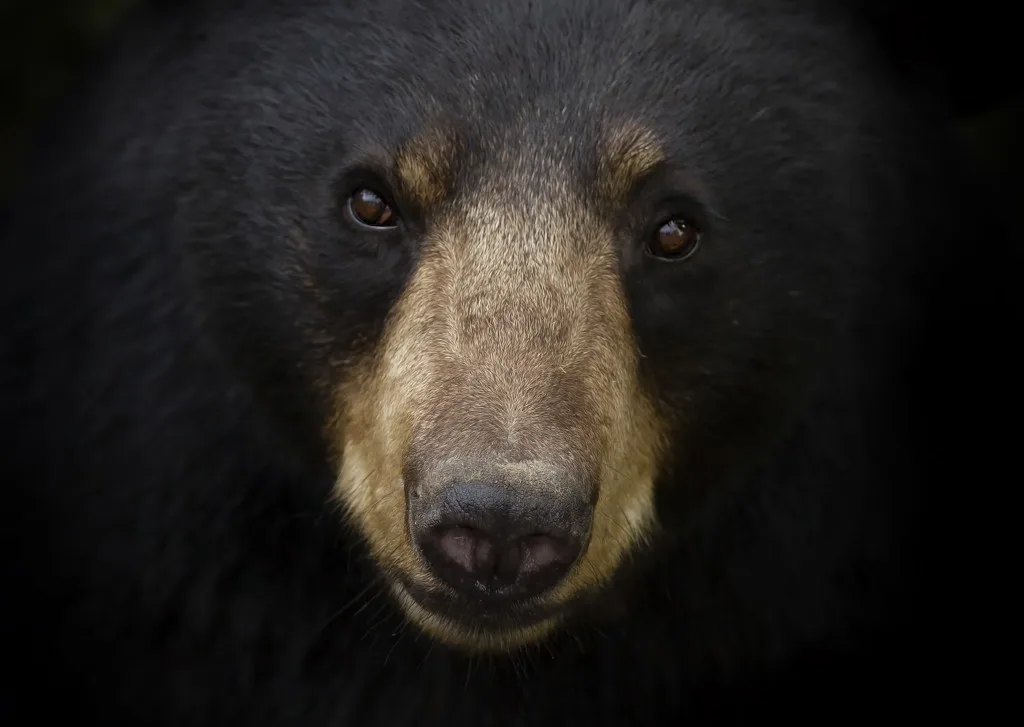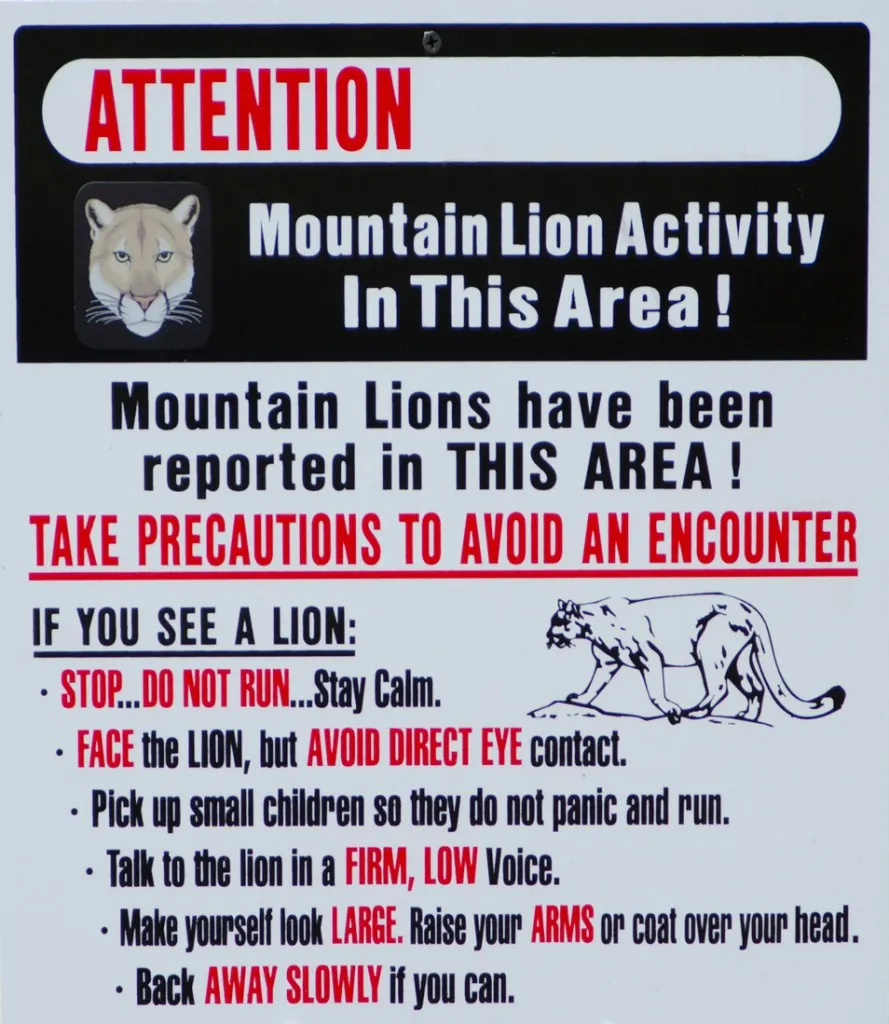Any large forested area, such as the Smoky Mountains, is bound to have dangerous creatures.
That shouldn’t prevent you from exploring as long as you know what to look out for and how to handle experiences that are too close.
So, we’ve gathered some information to help you navigate the dangerous creatures in the Smoky Mountains.
Let’s go!
The Most Dangerous Creatures in the Smokies
Black Bears – The Most Dangerous Animal in the Smokies
The American Black Bear is so prevalent in the Smoky Mountains that it’s become their symbol. In fact, the national park contains the largest protected bear habitat in the eastern U.S. Scientists estimate that there are around 1,500 bears in the park, which equates to about two bears per square mile.
Because of their population density, your chance of seeing a bear in the Smoky Mountains is relatively high. This is especially true if you’re around someone not following bear precautions, such as using food lockers and tossing your trash immediately.
Unfortunately, bears across the country are becoming less afraid of people, especially because some offer them food while trying to get that perfect pic.

One of the biggest dangers with bears in the Smokies is that they’re known to sniff out food as you’re carrying it from your car to your cabin or RV. Scent carries more strongly with hot food, so don’t hang around outside if you’ve just picked up dinner to-go. If a bear’s hungry and smells food, it will come after it aggressively.
Drop the food, and back away slowly with your arms raised until you’re safe inside a building or your RV.
Bears are also territorial and protective. If you come across a cub, do not approach it! Mama is sure to be nearby, and your life is not worth a moment of cuteness. The National Park Service states, “Willfully approaching within 50 yards (150 feet), or any distance that disturbs or displaces a bear is illegal in the park.
Violation of this federal regulation can result in fines and arrest. Use binoculars, a telephoto lens, or a spotting scope to view the animals.”
Know Before You Go: Learn how to behave around bears before you visit their territory.
Mountain Lions – A Rare Dangerous Cat in the Smokies
The Eastern Cougar, or Mountain Lion, was once considered gone from the Smoky Mountains. However, rare sightings have become more prevalent in recent years. Scientists haven’t yet seen evidence of a breeding population but have confirmed about 40% of stated sightings.
This means the big cats are likely passing through, but they’re still dangerous creatures you must know about when visiting the Smoky Mountains.
Mountain lions generally stay away from people, and deaths are uncommon. However, they may attack children or your pets if they’re hungry and presented with easy prey. Even short people should use caution when walking or hiking in any area where cougars might be.

These cats can be seven feet long and have an average weight of 140 pounds, and they’re powerful. They often climb trees and can jump from above, or they may strike from behind. The best way to prevent a mountain lion attack is to keep together as a group and ensure your children and pets don’t get too far behind or in front of you.
They also prefer to be out in the evening and nighttime, so try to be back at camp by dusk.
If you do come across a mountain lion, do not run and do not approach it. Both actions will trigger its attack behavior. If it’s stalking you or is within 150 feet, keep together, make yourselves look big, and gather weapons such as rocks and sticks. Never turn your back on a mountain lion.
If it actually attacks, fight as hard as you can, aiming for the face and eyes with your weapons, even if those are just your fingers and teeth.
Elk – The Smoky Mountains Dangerous Defenders
The National Park Service reintroduced Elk to the Smoky Mountains in 2001, and they’re now thriving. They won’t come after your food like the bears, but they’ll become very aggressive and even charge you if they feel you’re a danger or challenging them.
Male Elk can be as heavy as 700 pounds with antlers up to five feet wide. Add in their hooves, and that’s a lot of power and sharp things coming at you! In addition, the rut – or mating season – makes the males even more hostile. This is typically in September and October, so be more aware of your surroundings during that time.
One special note is that the babies will play dead if they feel threatened.

Don’t walk up to check on it because Mom is very likely nearby and will charge you. She may not have antlers, but her hooves are just as dangerous. If you feel an elk is injured or ill, contact the rangers to report it.
In the park and most other areas, it’s illegal to get within 150 feet of an elk. However, accidents happen, and you may find yourself closer than is safe. Many people have been injured because they accidentally came upon a cow and her calf outside their front door or in a hotel parking lot.
If you find yourself too close to an elk, back away slowly and don’t look them in the eyes, especially the males. But do keep an eye on them. If the elk charges you, run!
Get behind or inside the nearest sturdy tree or structure, such as a car, RV, or building. If they get you on the ground, curl into a fetal position to protect your face and head. With luck, you’ll get a couple of kicks before they walk away.
Snakes – Sneaky Dangers in the Smokies
According to the National Park Service, the Great Smoky Mountains National Park has 23 species of snake, but only two of these are venomous. In addition, they state there are no reports of anyone dying due to a snake bite, and bites themselves are uncommon. Still, you’ll want to be cautious, especially when hiking through grassy areas.
Northern Copperhead and Timber Rattlesnakes are the ones you’ll want to watch out for. Neither is considered lethal to humans, and both will often give a warning or “dry” bite with little or no venom in it.
Regardless, you should seek medical attention if bitten by a snake to ensure you receive proper treatment in case of neurological problems, soft tissue damage, or other symptoms.
Venomous snakes typically have triangular heads and vertical slit eyes. Rattlesnakes are usually brown, sometimes with orange or black. The easier way to identify a rattler is by the telltale rattle they use as a warning. You’ll mostly find Timber Rattlesnakes above 3,000 feet in the Smokies. They like to hang out on rocky ledges, and anywhere they can soak up the sun.
Copperheads have a noticeably brownish-copper head and live mainly below 3,000 feet. In cooler months, they tend to hide in rock fissures or under stumps and along streams. Both snakes like to hide under buildings and fences too.
As with most animals, they’ll typically only attack if they feel threatened. So be aware of your surroundings and watch where you’re placing your hands and feet. And, again, if one does bite you, seek proper medical attention.
You may just feel bad for a while, or you could have stronger symptoms. Either way, it’s best to have a professional take a look.

Less Dangerous Animals of the Smokies
Less dangerous animals such as wild boars, bobcats, and coyotes also live in the Smoky Mountains. They don’t usually attack humans unless they feel threatened or if you’ve come too close to their babies.
Wild Boars are especially violent if you get near their children, using their tusks to stab violently. Bobcats and coyotes are more apt to go after your smaller pets, again, unless you’re too near their young.
Even raccoons, foxes, and skunks can be dangerous, even though most people don’t think of them that way. Sure, a skunk can spray you or your dog or your camping gear, but there are ways to get the smell out – eventually. However, all three species can carry rabies, which is deadly to humans and our pets.

Encouraging them with food, or trying to pet the cute little guys, is not a good idea. One bite and you’re on your way to the hospital.
Snapping turtles aren’t dangerous unless you try to pet or feed one or invade their nest. Even then, they’re relatively harmless because their bite pressure is less than a human’s.
That said, their saliva and skin contain salmonella bacteria, which can cause sickness or death in humans. So, if you or your dog get bit, seek medical attention quickly, especially if it breaks the skin.
Be Aware of the Dangers and Still Enjoy the Smoky Mountains
We don’t mean to scare you away from the Smoky Mountains. Certainly, you can find many of these animals across the country in urban or suburban areas. Be aware, though, and take precautions when you’re in their territory.
That way, you and the animals can enjoy the Great Smoky Mountains. Have you ever come across any of these animals? Tell us your story!
Discover the Best Free Camping Across the USA
To be honest with you, we hate paying for camping. There are so many free campsites in America (with complete privacy).
You should give it a try!
As a matter of fact, these free campsites are yours. Every time you pay federal taxes, you’re contributing to these lands.
Become a FREE CAMPING INSIDER and join the 100,000 campers who love to score the best site!
We’ll send you the 50 Best Free Campsites in the USA (one per state). Access the list by submitting your email below:
Tourists are the most dangerous thing in the Great Smokies National Park.